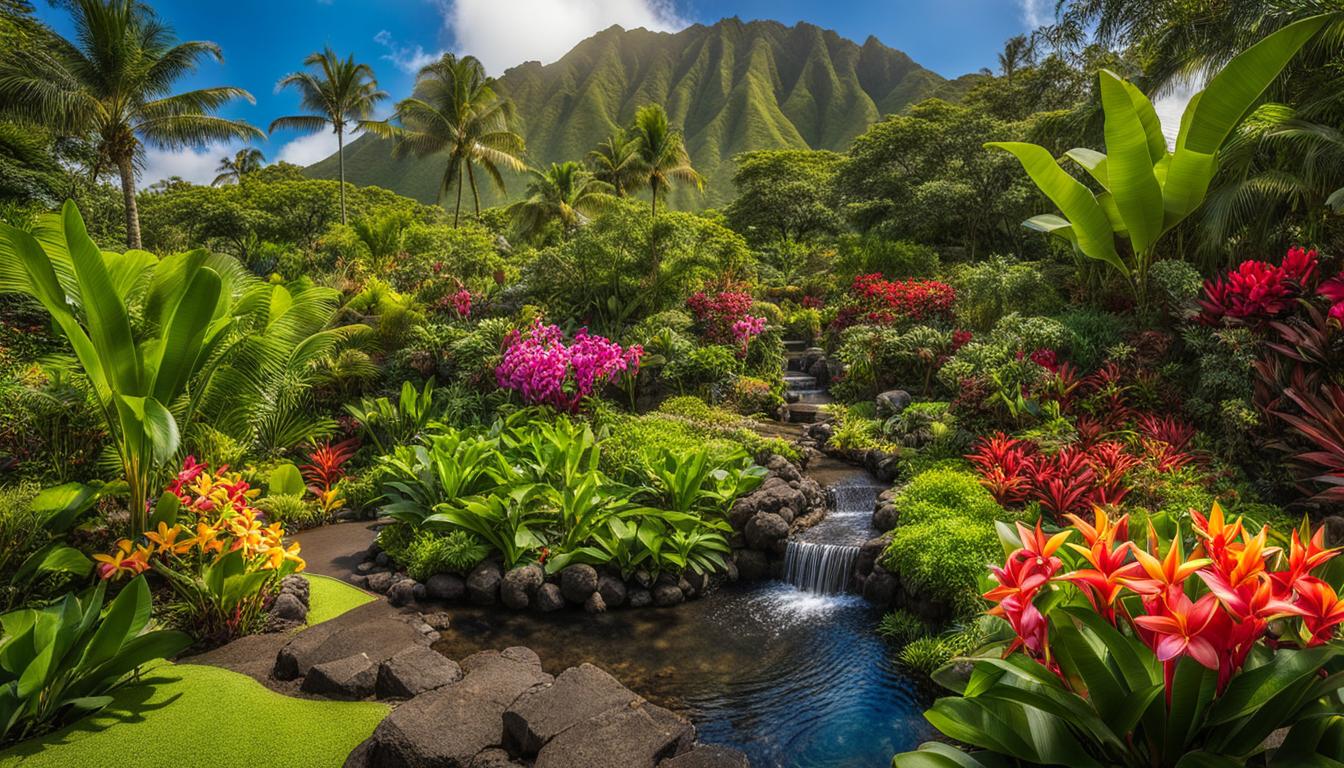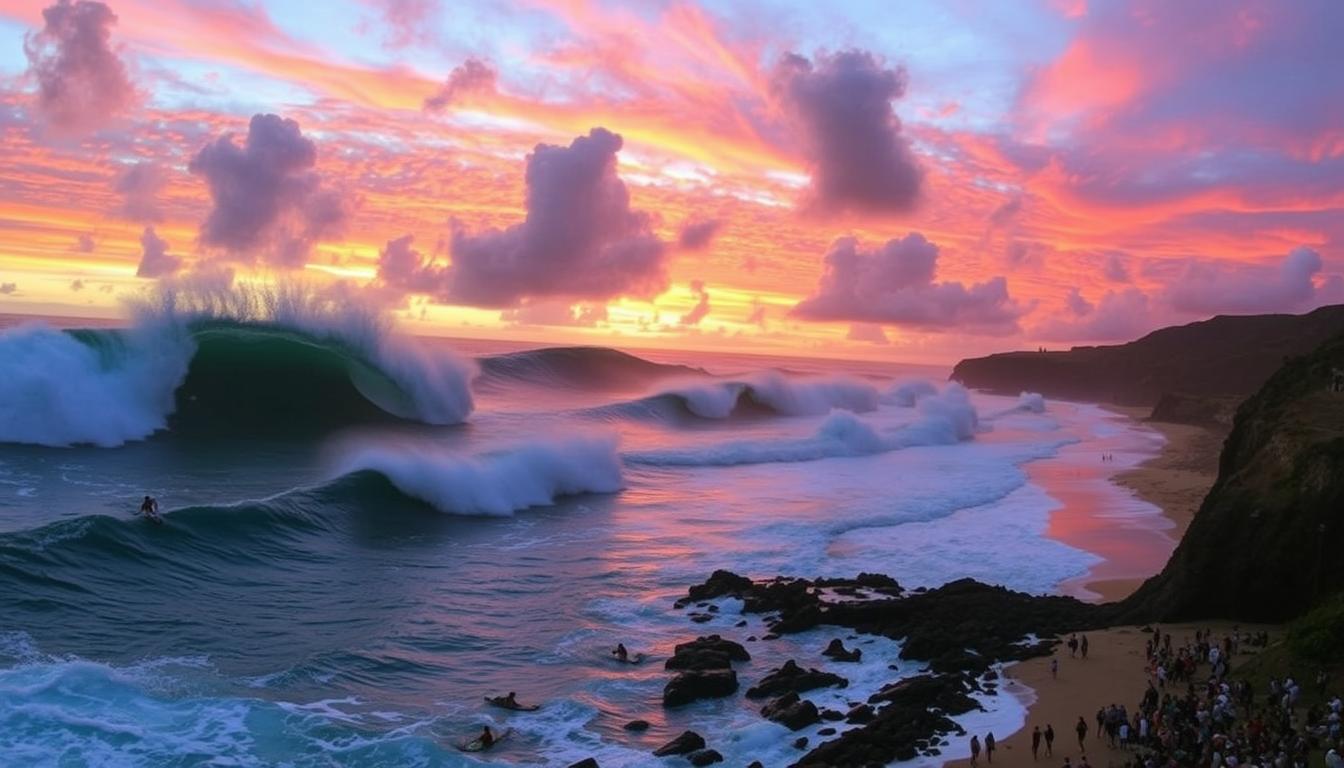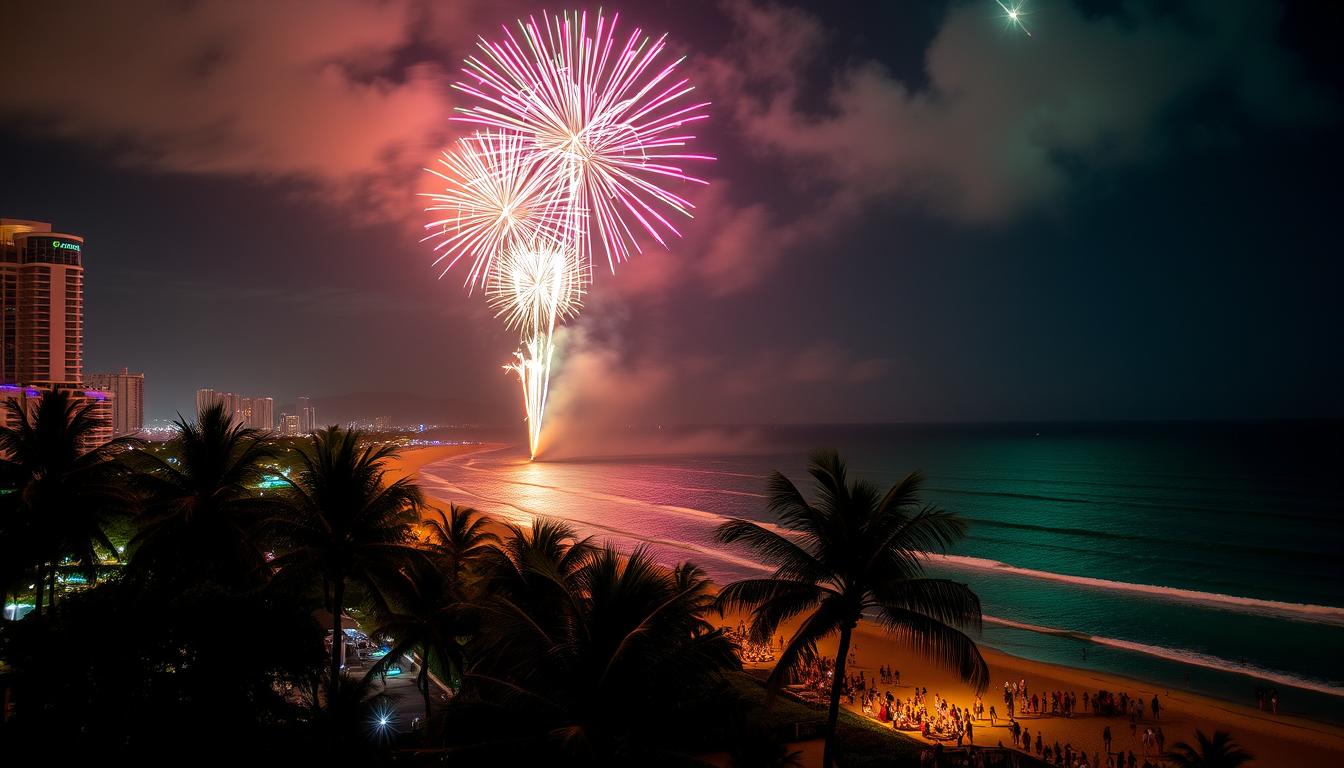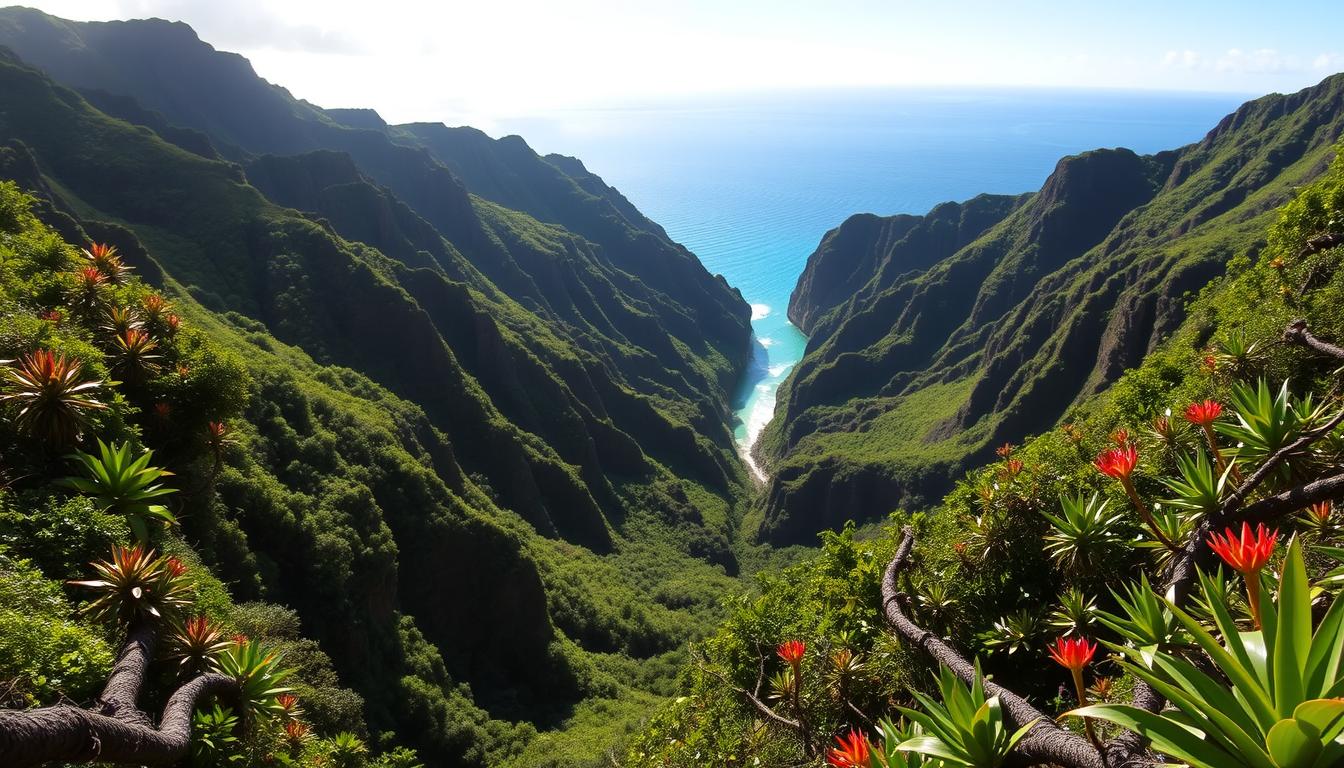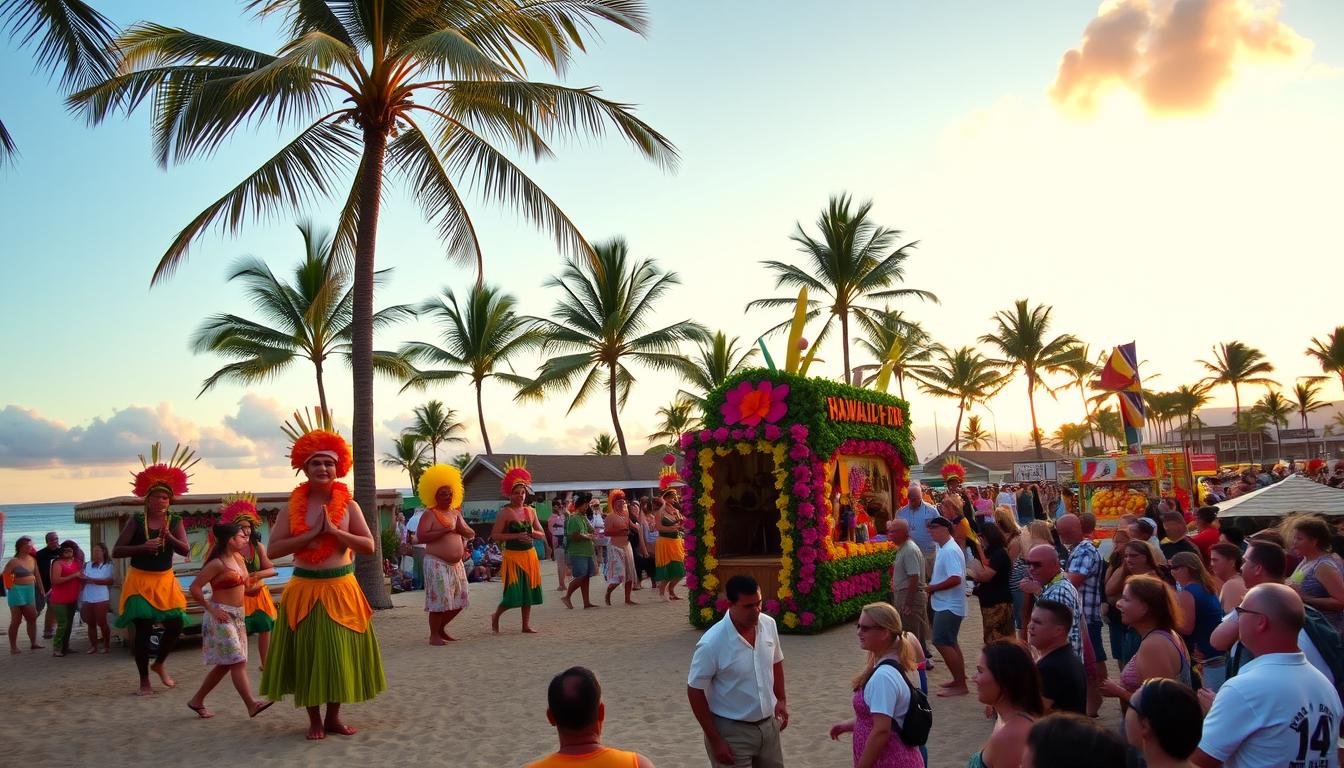Welcome to the lush and tropical paradise of Hawaii, where you can immerse yourself in the beauty of its botanical gardens. The Big Island, located on the northeastern side, is home to several breathtaking gardens that showcase the diverse flora and fauna of the region. Whether you’re a nature enthusiast, a plant lover, or simply seeking tranquility in stunning surroundings, these botanical gardens are a must-visit during your time in Hawaii.
Key Takeaways:
- Explore the lush and tropical botanical gardens of Hawaii’s Big Island.
- Discover the diverse flora and fauna that call these gardens home.
- Immerse yourself in the beauty and tranquility of these stunning natural landscapes.
- Learn about the unique plants and their traditional uses in Hawaiian culture.
- Plan your itinerary and map out your visit to these must-see botanical gardens.
Map of Botanical Gardens
Exploring the botanical gardens on the Big Island of Hawaii is a delightful experience for nature enthusiasts. To make the most of your visit and easily locate the gardens, a map can be a helpful tool. With markers indicating the various botanical gardens, regular gardens, and arboretums scattered across the island, you can plan your itinerary and navigate the lush paradise with ease.
Whether you’re looking to immerse yourself in the serene beauty of Hawaii’s flora or indulge in educational opportunities, the botanical gardens map will be your guide. From the northeastern side of the island, where the gardens are abundant, to other hidden gems waiting to be discovered, the map ensures that you don’t miss out on any of the stunning displays of tropical plants and flowers.
Take a moment to marvel at the wondrous diversity of Hawaii’s botanical gardens and plan your journey through paradise.
| Botanical Garden | Location |
|---|---|
| Hawaii Tropical Bioreserve & Gardens | Hilo/Hamakua |
| Panaʻewa Rainforest Zoo & Botanical Gardens | Hilo |
| Botanical Gardens at the University of Hawaii | Hilo |
| World Botanical Gardens | Hilo/Hamakua |
| Pua Mau Botanical Gardens | Waimea/Kohala |
Embark on a botanical adventure and discover the hidden treasures of the Big Island’s botanical gardens. From the Hawaii Tropical Bioreserve & Gardens in Hilo to the Pua Mau Botanical Gardens in Waimea/Kohala, each garden offers its own unique charm and beauty. Take a moment to explore the table below, which highlights some of the must-visit botanical gardens on the island:
List of Botanical Gardens
Visitors to the Big Island can explore a variety of botanical gardens, each offering a unique and beautiful display of Hawaii’s flora and fauna. Here is a list of some of the must-visit botanical gardens on the island:
- Hawaii Tropical Bioreserve & Gardens: Located in Hilo/Hamakua, the Hawaii Tropical Bioreserve & Gardens is a 40-acre valley filled with over 2,000 species of tropical plants. It is dedicated to the collection and display of the world’s tropical plants and offers educational opportunities for visitors.
- Pana’ewa Rainforest Zoo & Botanical Gardens: Situated in Hilo, this unique attraction combines a zoo and botanical garden. Visitors can explore over 100 types of palm trees, tropical rhododendrons, and native forest areas.
- Botanical Gardens at the University of Hawaii: Located in Hilo, the Botanical Gardens at the University of Hawaii feature three separate areas focusing on cycads, bromeliads, and palms. It boasts one of the largest collections of cycads in Hawaii.
- World Botanical Gardens: Situated in Hilo/Hamakua, the World Botanical Gardens covers 300 acres of former sugarcane fields. Visitors can enjoy a 100 ft waterfall, a 10-acre maze, and specialized garden areas on a self-guided or zip line guided tour.
- Pua Mau Botanical Gardens: Located in Waimea/Kohala, Pua Mau Botanical Gardens offer stunning views of the Pacific Ocean. It features a maze planted with over 200 varieties of hibiscus and an aviary with peafowl and guinea fowl.
- Amy B. H. Greenwell Ethnobotanical Garden: Situated in Captain Cook/south Kona, this garden showcases plants used by ancient Hawaiians for various purposes. Visitors can learn about Hawaiian ethnobotany and explore the diverse collection of plants.
- Sadie Seymour Botanical Gardens: Located in Kona, Sadie Seymour Botanical Gardens provide an overview of native and non-native plants found in Hawaii. While not as expansive as other botanical gardens, it is still worth a visit.
- Nani Mau Gardens: Situated in Hilo, Nani Mau Gardens cover 20 acres and feature various garden areas, including a Japanese-style bell tower, a fruit orchard, and a water garden.
- Paleaku Gardens: Located in Captain Cook, Paleaku Gardens is a haven of tranquility and meditation. It is known for its beautiful views, serene atmosphere, and spiritual events.
Each of these botanical gardens offers a unique experience for visitors, showcasing the natural beauty and diversity of Hawaii’s plant life. Whether you’re interested in tropical plants, native species, or learning about Hawaiian culture, the Big Island’s botanical gardens have something for everyone.
Table: Comparison of Botanical Gardens
| Botanical Garden | Location | Highlights |
|---|---|---|
| Hawaii Tropical Bioreserve & Gardens | Hilo/Hamakua | Over 2,000 species of tropical plants |
| Pana’ewa Rainforest Zoo & Botanical Gardens | Hilo | Combination of zoo and botanical garden |
| Botanical Gardens at the University of Hawaii | Hilo | Large collection of cycads |
| World Botanical Gardens | Hilo/Hamakua | Waterfall, maze, specialized garden areas |
| Pua Mau Botanical Gardens | Waimea/Kohala | Maze with over 200 varieties of hibiscus |
| Amy B. H. Greenwell Ethnobotanical Garden | Captain Cook/south Kona | Showcase of Hawaiian ethnobotany |
| Sadie Seymour Botanical Gardens | Kona | Overview of native and non-native plants |
| Nani Mau Gardens | Hilo | Japanese-style bell tower, fruit orchard |
| Paleaku Gardens | Captain Cook | Spiritual events, serene atmosphere |
Hawaii Tropical Bioreserve & Gardens (Hilo/Hamakua)
The Hawaii Tropical Bioreserve & Gardens, located in Hilo, is a must-visit destination for nature enthusiasts and botanical garden lovers. Spanning 40 acres, this stunning botanical garden is home to over 2,000 species of tropical plants, making it a true paradise for plant enthusiasts and nature photographers.
Visitors to the Hawaii Tropical Bioreserve & Gardens have the opportunity to explore a diverse range of tropical plants, including vibrant flowers, towering palm trees, and lush foliage. The garden’s layout is thoughtfully designed, with winding paths that lead visitors through different sections, each showcasing a unique collection of plants.
One of the highlights of the Hawaii Tropical Bioreserve & Gardens is the educational opportunities it offers. Visitors can participate in guided tours and workshops, where they can learn about the various plant species, their habitats, and their importance in Hawaii’s ecosystems. It’s a fantastic opportunity to gain a deeper understanding of Hawaii’s rich botanical heritage.
Whether you’re a plant enthusiast, a nature lover, or simply looking for a tranquil escape, the Hawaii Tropical Bioreserve & Gardens is a must-visit attraction in Hilo. Immerse yourself in the beauty of tropical plants, explore the garden’s diverse landscapes, and gain a newfound appreciation for the wonders of nature.
| Location | Address | Contact |
|---|---|---|
| Hilo | 27-717 Mamalahoa Hwy, Pepeekeo, HI 96783 | (808) 964-5233 |
| Hamakua | 27-717 Mamalahoa Hwy, Pepeekeo, HI 96783 | (808) 964-5233 |
Panaʻewa Rainforest Zoo & Botanical Gardens (Hilo)
The Panaʻewa Rainforest Zoo & Botanical Gardens in Hilo is a must-visit destination for nature enthusiasts. This unique attraction combines the beauty of a botanical garden with the excitement of a zoo, offering visitors a chance to explore a diverse range of flora and fauna.
As a free zoo and botanical garden, Panaʻewa Rainforest provides an accessible and enjoyable experience for all. Visitors can wander through the lush greenery, discovering over 100 species of palm trees and vibrant tropical rhododendrons. The garden’s serene atmosphere and the soothing sounds of chirping birds create a peaceful escape from the hustle and bustle of daily life.
One of the highlights of Panaʻewa Rainforest is its focus on conservation and education. The zoo section of the gardens is home to a variety of native and exotic animals, including endangered species like the Hawaiian Monk Seal and Nene Goose. Visitors can learn about these fascinating creatures and their habitats through informational panels and interactive exhibits.
Panaʻewa Rainforest Zoo & Botanical Gardens Highlights:
- Over 100 species of palm trees
- Tropical rhododendrons
- Free admission
- Hawaiian wildlife exhibits
- Educational programs
About the Panaʻewa Rainforest Zoo:
| Location | Hours | Admission |
|---|---|---|
| 800 Stainback Highway, Hilo, HI 96720 | Open daily from 9:00 AM to 4:00 PM | Free |
Botanical Gardens at the University of Hawaii (Hilo)
The Botanical Gardens at the University of Hawaii in Hilo offer a diverse and captivating collection of plant species, with a particular emphasis on cycads, bromeliads, and palms. This botanical haven spans three separate areas, each with its own unique features and plant displays. One of the highlights of the gardens is the extensive collection of cycads, which is one of the largest in Hawaii. These ancient and fascinating plants have a rich history dating back millions of years.
Zamia is a notable genus of cycads that can be found in the Botanical Gardens at the University of Hawaii. These resilient plants have adapted to various environments and are known for their attractive foliage and fascinating reproductive structures. The gardens also showcase rare and endangered plants from Africa, Australia, and China, allowing visitors to appreciate the diversity of plant life from around the world.
Horticulture enthusiasts and nature lovers alike will appreciate the educational opportunities provided by the Botanical Gardens at the University of Hawaii. Guided tours and informational signage offer insights into the unique characteristics and ecological importance of the plants on display. Visitors can spend hours exploring the gardens, immersing themselves in the beauty of nature, and learning about the fascinating world of plants.
Table: Highlights of the Botanical Gardens at the University of Hawaii (Hilo)
| Area | Plant Collections | Special Features |
|---|---|---|
| Cycad Garden | Large collection of cycads | |
| Bromeliad Garden | Diverse range of bromeliad species | |
| Palm Garden | Various palm species |
Whether you have a specific interest in cycads or simply want to immerse yourself in the beauty of botanical gardens, a visit to the Botanical Gardens at the University of Hawaii in Hilo is a must. The gardens provide a tranquil escape where visitors can appreciate the wonders of nature and gain a deeper understanding of plant life.
World Botanical Gardens (Hilo/Hamakua)
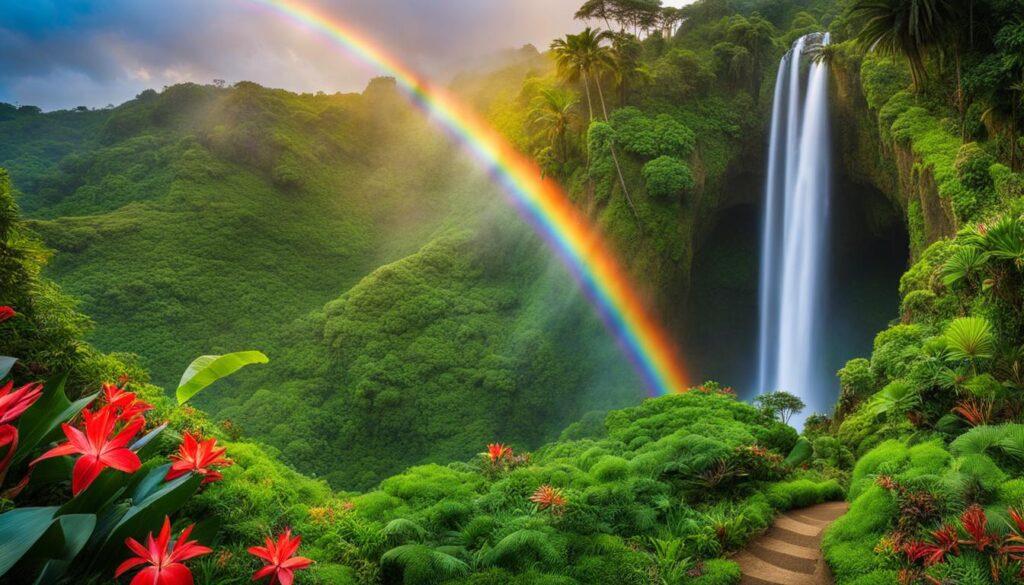
The World Botanical Gardens is a stunning paradise located in Hilo/Hamakua, Hawaii. Spanning over 300 acres of former sugarcane fields, this commercial botanical garden offers a diverse and immersive experience for nature lovers and adventure enthusiasts alike. With its enchanting landscapes, breathtaking waterfalls, and thrilling zip line guided tour, the World Botanical Gardens is a must-visit destination on the Big Island.
One of the highlights of the World Botanical Gardens is the majestic Kamaʻeʻe Falls, a 100 ft waterfall cascading into a tranquil pool below. Visitors can enjoy the mesmerizing beauty of the falls and immerse themselves in the peaceful surroundings. The sight and sound of the rushing water create a serene atmosphere, perfect for relaxation and rejuvenation.
For those seeking a thrilling adventure, the zip line guided tour at the World Botanical Gardens is an unforgettable experience. Soar through the lush canopy of trees, taking in the panoramic views of the gardens and the surrounding landscape. Feel the rush of adrenaline as you glide from one platform to another, witnessing the beauty of nature from an exhilarating perspective.
Table: World Botanical Gardens – Visitor Information
| Opening Hours | 9:00 AM – 5:30 PM |
|---|---|
| Admission Fee | $20 per adult $10 per child (ages 6-16) Free for children under 6 |
| Zip Line Guided Tour | $165 per person |
| Address | 31-240 Old Mamalahoa Highway, Hakalau, HI 96710 |
| Contact | Phone: (808) 963-5427 Email: info@worldbotanicalgardens.com |
Pua Mau Botanical Gardens (Waimea/Kohala)
Pua Mau Botanical Gardens, situated on the western slope of the Kohala Mountain, offers a breathtaking experience with stunning views of the Pacific Ocean. Spanning across several acres, this botanical garden boasts a diverse collection of plant species that will captivate nature enthusiasts.
One of the highlights of Pua Mau Botanical Gardens is the impressive hibiscus maze, featuring over 200 varieties of hibiscus. As you wander through the labyrinth of vibrant colors and intricate patterns, you’ll discover the beauty and diversity of these exquisite flowers. The maze provides a unique and interactive way to explore the garden while immersing yourself in the tropical ambiance.
From the visitor center deck, visitors can also enjoy DIY whale watching during the months of December to March. The deck offers an elevated vantage point to observe these majestic creatures as they migrate through the Pacific waters. It’s a truly extraordinary experience that combines the beauty of the botanical gardens with the awe-inspiring sight of whales in their natural habitat.
Table: Pua Mau Botanical Gardens’ Highlights
| Feature | Description |
|---|---|
| Hibiscus Maze | A maze featuring over 200 varieties of hibiscus |
| Aviary | An aviary home to peafowl and guinea fowl |
| Whale Watching | Opportunity to spot whales from the visitor center deck |
| Scenic Views | Breathtaking views of the Pacific Ocean |
Whether you’re drawn to the vibrant hibiscus maze, the enchanting aviary, or the captivating whale watching, Pua Mau Botanical Gardens offers a memorable experience for nature lovers of all ages. Immerse yourself in the beauty of Hawaii’s flora while enjoying the picturesque surroundings and breathtaking views of the Pacific Ocean.
Amy B. H. Greenwell Ethnobotanical Garden (Captain Cook/south Kona)
The Amy B. H. Greenwell Ethnobotanical Garden is a hidden gem located in Captain Cook, South Kona. This unique botanical garden showcases the rich history of Hawaiian ethnobotany, focusing on the traditional uses of plants by the ancient Hawaiians. The garden is dedicated to preserving and sharing the knowledge of how plants were utilized for food, medicine, construction, and cultural practices.
Visitors to the Amy B. H. Greenwell Ethnobotanical Garden can explore the diverse collection of plants that were integral to the daily lives of the Hawaiian people. The garden features over 200 native and introduced plant species, many of which have significant cultural and historical importance. Guided tours are available for a deeper understanding of the traditional uses of plants and the stories behind them.
One of the highlights of the garden is the ethno-archaeological village site, which offers a glimpse into the daily life of ancient Hawaiians. Here, visitors can see reconstructed traditional structures and learn about the cultural practices and rituals associated with these plants. The garden also hosts educational programs and workshops, allowing visitors to engage with Hawaiian culture and gain a deeper appreciation for the natural resources of the islands.
Table: Traditional Uses of Plants at Amy B. H. Greenwell Ethnobotanical Garden
| Plant | Traditional Use |
|---|---|
| ʻAwa | Used for its sedative and relaxing properties in traditional ceremonies and medicinal practices. |
| Kalo | An important staple food, used to make poi, a traditional Hawaiian dish. |
| Kukui | The nuts of the kukui tree were used for lighting, and the oil was utilized for medicinal purposes. |
| Ohe | The stems of the bamboo plant were used for construction and crafting, such as making tools, utensils, and musical instruments. |
| Noni | Used for its medicinal properties, including treating skin ailments and boosting the immune system. |
Exploring the Amy B. H. Greenwell Ethnobotanical Garden provides a unique opportunity to delve into the traditional Hawaiian way of life and gain a deeper understanding of the cultural significance of plants. Whether you’re interested in history, botany, or simply immersing yourself in the beauty of nature, this garden offers a captivating experience that is both educational and inspiring.
Sadie Seymour Botanical Gardens (Kona)
The Sadie Seymour Botanical Gardens, located in Kona, showcases a diverse collection of native and non-native plants found in Hawaii. While not as expansive as the botanical gardens in Hilo, it still offers a delightful opportunity for visitors to immerse themselves in the beauty of Hawaii’s flora and fauna.
In these gardens, you’ll find a wide variety of plants, including native Hawaiian species and plants from other regions. This eclectic mix creates a unique and vibrant atmosphere, providing a glimpse into the rich biodiversity of the Hawaiian Islands.
Whether you’re a nature enthusiast or simply looking to explore the botanical wonders of Hawaii, a visit to the Sadie Seymour Botanical Gardens is sure to leave you with a deeper appreciation for the natural world.
Table: Highlights of Sadie Seymour Botanical Gardens
| Feature | Description |
|---|---|
| Native Plants | Explore the rich diversity of native Hawaiian plants. |
| Non-Native Plants | Discover exotic plants from around the world. |
| Scenic Views | Take in the breathtaking beauty of the Kona region. |
| Education | Learn about the importance of conservation and sustainable practices. |
| Peaceful Atmosphere | Enjoy a tranquil escape surrounded by nature’s beauty. |
Nani Mau Gardens (Hilo)
Nani Mau Gardens, located in Hilo, is a picturesque 20-acre botanical paradise that offers a delightful experience for nature enthusiasts. The gardens showcase a variety of garden areas, each with its own unique charm and beauty.
One of the highlights of Nani Mau Gardens is the Japanese-style bell tower. This tranquil structure adds an element of elegance to the surroundings and provides a peaceful atmosphere for visitors to enjoy. The soothing sound of the bell resonates through the gardens, creating a serene ambiance.
Another attraction in Nani Mau Gardens is the fruit orchard. Take a leisurely stroll through the orchard and discover an abundance of tropical fruits. From juicy pineapple to exotic mangoes, the fruit orchard showcases the rich variety of flavors that thrive in the Hawaiian climate.
Immerse yourself in the beauty of Nani Mau Gardens as you explore the meticulously landscaped grounds and vibrant displays of flora. Whether you’re a nature lover, a photography enthusiast, or simply seeking a peaceful escape, Nani Mau Gardens is a must-visit destination on the Big Island of Hawaii.
FAQ
Are there any maps available for the botanical gardens on the Big Island?
Yes, there are maps available to help visitors locate the botanical gardens on the Big Island. These maps include markers for botanical gardens, regular gardens, and arboretums on the island.
How many botanical gardens can I visit on the Big Island?
There are several botanical gardens to explore on the Big Island. Some of the popular ones include the Hawaii Tropical Bioreserve & Gardens, Pana’ewa Rainforest Zoo & Botanical Gardens, botanical gardens at the University of Hilo, World Botanical Gardens, Pua Mau botanical gardens, Amy B. H. Greenwell Ethnobotanical Garden, Sadie Seymour botanical gardens, Nani Mau botanical gardens, and Paleaku gardens.
What can I expect to see at the Hawaii Tropical Bioreserve & Gardens?
The Hawaii Tropical Bioreserve & Gardens is a 40-acre valley filled with over 2,000 species of tropical plants. It is dedicated to the collection and display of the world’s tropical plants and offers educational opportunities for visitors of all ages.
What makes the Panaʻewa Rainforest Zoo & Botanical Gardens unique?
The Panaʻewa Rainforest Zoo & Botanical Gardens is a unique combination of a zoo and botanical garden. Visitors can see over 100 types of palm trees and tropical rhododendrons, as well as explore the native forest and agro-forest areas.
What are the highlights of the Botanical Gardens at the University of Hawaii?
The Botanical Gardens at the University of Hawaii feature three separate areas with a focus on cycads, bromeliads, and palms. The gardens have one of the largest collections of cycads in Hawaii and also include rare and endangered plants from Africa, Australia, and China.
What can I expect at the World Botanical Gardens?
The World Botanical Gardens is a commercial botanical garden situated on 300 acres of former sugarcane fields. It features a 100 ft waterfall, a 10-acre maze, and specialized garden areas. Visitors can explore the gardens on a self-guided tour or as part of a zip line guided tour.
What makes the Pua Mau Botanical Gardens special?
Pua Mau Botanical Gardens is located on the western slope of the Kohala Mountain and offers stunning views of the Pacific Ocean. It features a maze planted with over 200 varieties of hibiscus and an aviary with peafowl and guinea fowl. Visitors can also try DIY whale watching from the visitor center deck during the months of December to March.
What is the focus of the Amy B. H. Greenwell Ethnobotanical Garden?
The Amy B. H. Greenwell Ethnobotanical Garden showcases the plants that were used by ancient Hawaiians for various purposes. Visitors can learn about Hawaiian ethnobotany and explore the diverse collection of plants in the garden.
How does the Sadie Seymour Botanical Gardens compare to the Hilo botanical gardens?
The Sadie Seymour Botanical Gardens span 1.5 acres and offer an overview of the native and non-native plants found in Hawaii. While not as expansive as the Hilo botanical gardens, it is still worth a visit for those passing by the area.
What can I expect at the Nani Mau Gardens?
Nani Mau Gardens covers 20 acres and features a variety of garden areas, including a Japanese-style bell tower, a fruit orchard, and a water garden. Visitors can explore the gardens and enjoy the beautiful displays of plants and flowers.
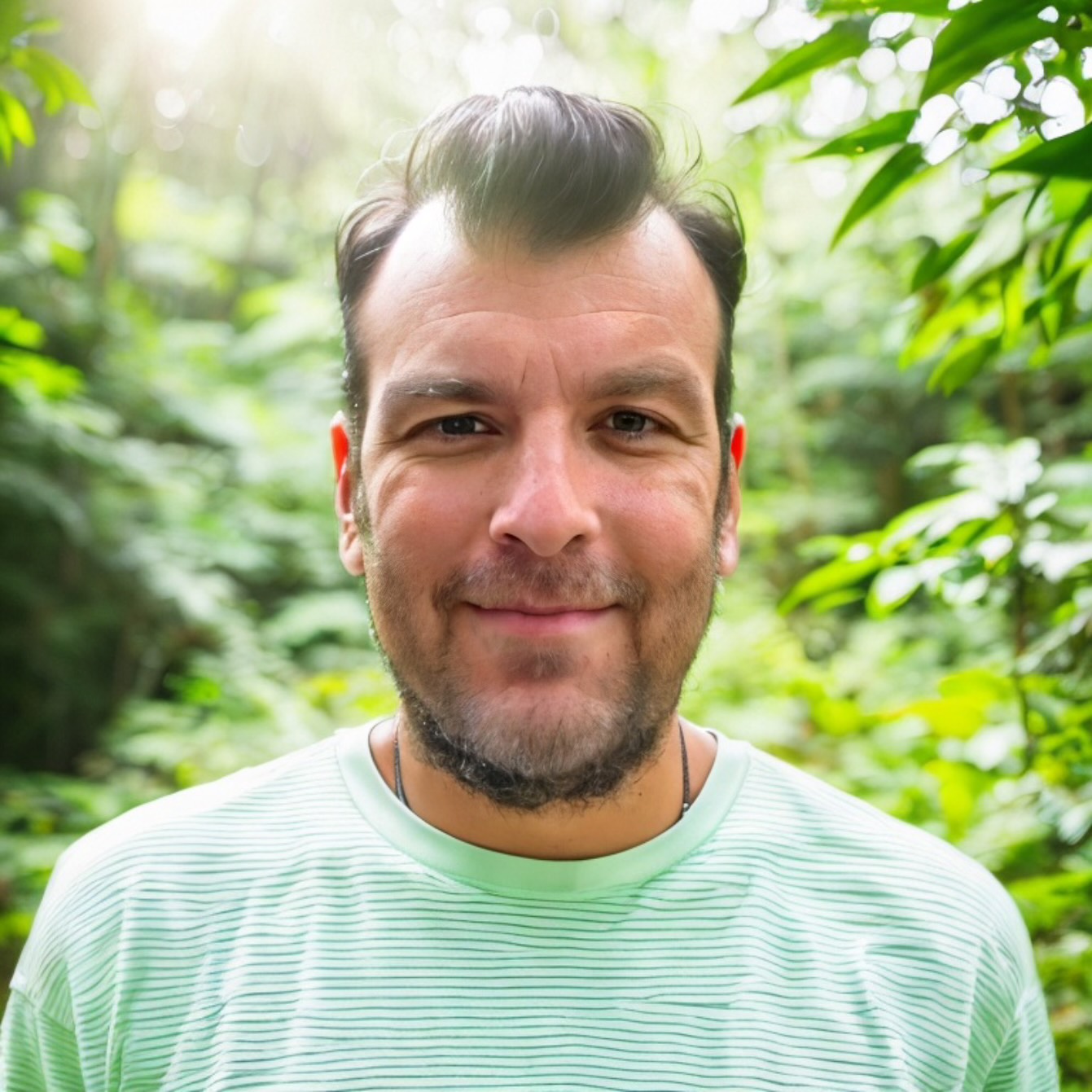
Scott Sweeney is the creator of Virtual Hawaii 360. Scott is a professional marketer and a lifelong Hawaii enthusiast. Scott splits time between Oahu and Dayton, Ohio. In addition to his marketing endevours, he is also a published Ukulele musician.

